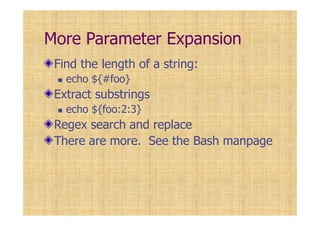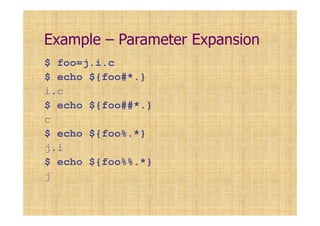This document provides an introduction to shell scripting using the bash shell. It covers key concepts such as shell variables, command substitution, quoting, aliases, and initializing files. The shell acts as both a command-line interface and programming language. It executes commands, supports scripting through variables and control structures, and reads initialization files on startup to customize the environment. Well-formed shell scripts allow combining and sequencing commands to perform automated tasks.
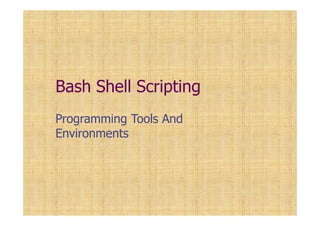

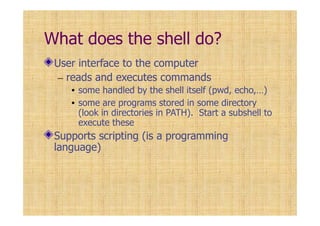
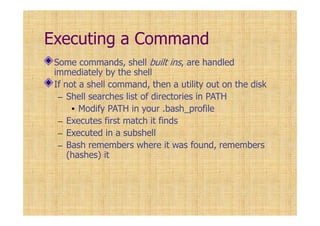

![Example
[jjohnson@ws44 cs265]$ which echo
/bin/echo
[jjohnson@ws44 cs265]$ type -a echo
echo is a shell builtin
echo is /bin/echo
[jjohnson@ws44 cs265]$ help echo
echo: echo [-neE] [arg ...]
Write arguments to the standard output.
Display the ARGs, separated by a single space character and followed by a
newline, on the standard output.
Options:
-n do not append a newline
-e enable interpretation of the following backslash escapes
-E explicitly suppress interpretation of backslash escapes
`echo' interprets the following backslash-escaped characters:
a alert (bell)
b backspace
...](https://image.slidesharecdn.com/shellscripting-160109063824/85/Shell-scripting-6-320.jpg)

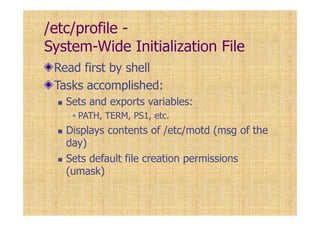
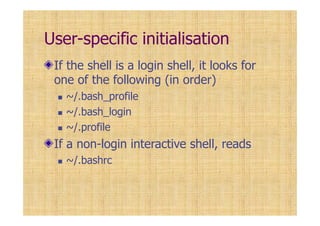


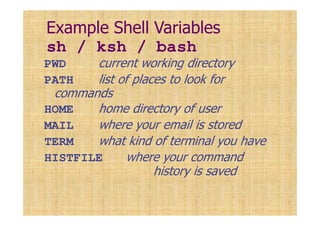
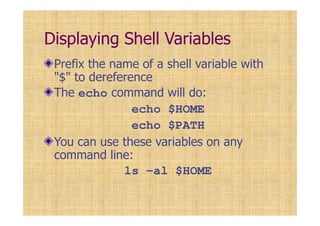
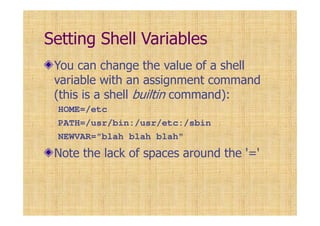
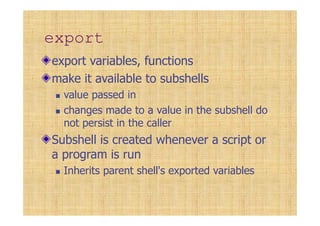
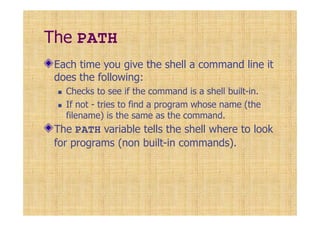
![echo $PATH
======= [tux] - 22:43:17 =======
$ echo $PATH
~/bin:/usr/local/sbin:/usr/local/bin:/usr/sbi
n:/usr/bin:/sbin:/bin:/usr/games
The PATH is a list of ":" delimited directories.
The PATH is a list and a search order.
You can add stuff to your PATH by changing the
shell startup file.](https://image.slidesharecdn.com/shellscripting-160109063824/85/Shell-scripting-17-320.jpg)
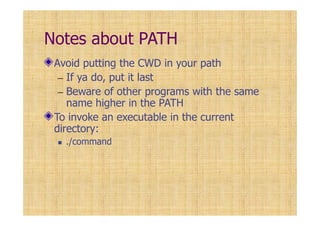
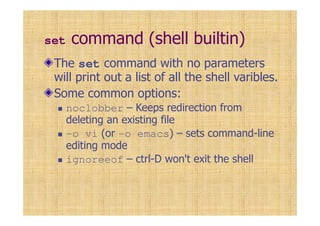
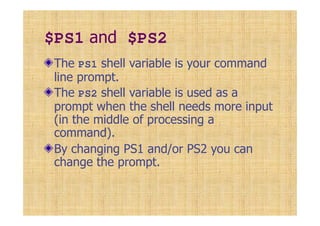
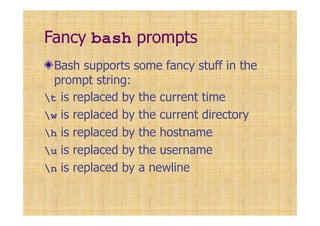
![Example bash prompt
======= [queen] - 22:43:17 =======
~ echo $PS1
======= [h] - t =======nw
You can change your prompt by
changing PS1:
PS1="Yes Master? "](https://image.slidesharecdn.com/shellscripting-160109063824/85/Shell-scripting-22-320.jpg)
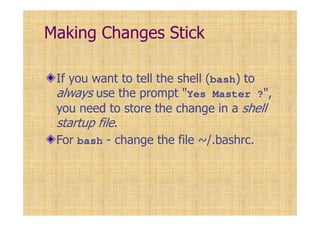
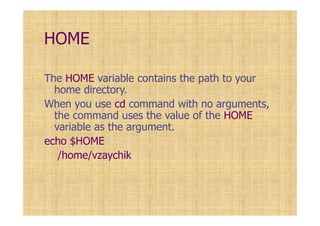
![Metacharacters
Shell metacharacters are characters that are
handled specially by the shell.
Below is an (incomplete) list of shell
metacharacters
> >> < << | Command redirection, pipe
* [] ? {} File specification
; & || && () Command Sequencing
# Line comment](https://image.slidesharecdn.com/shellscripting-160109063824/85/Shell-scripting-25-320.jpg)
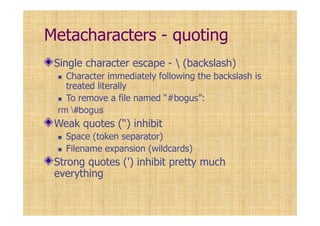
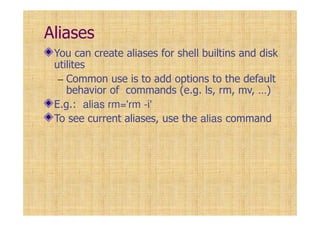
![Alias (cont)
Create an alias using the builtin command
alias name[=value]
You should usually enclose value in quotes.
no spaces around the '='
Without a value, alias prints out the alias associated
with name
alias dir=“ls”
alias ls=“ls -CF”
dir
Output same as for “ls -CF”](https://image.slidesharecdn.com/shellscripting-160109063824/85/Shell-scripting-28-320.jpg)
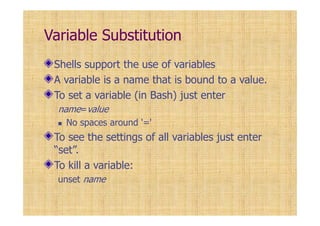

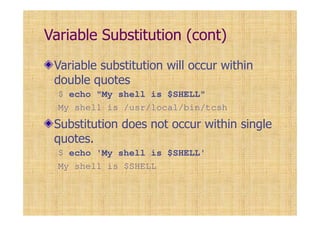
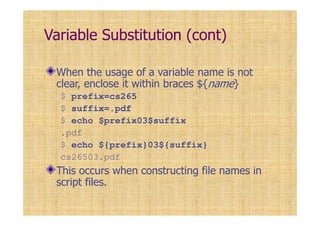
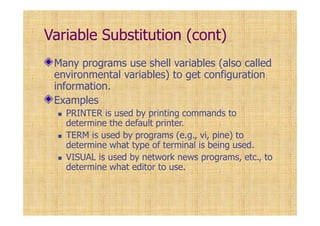
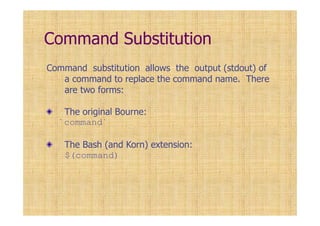
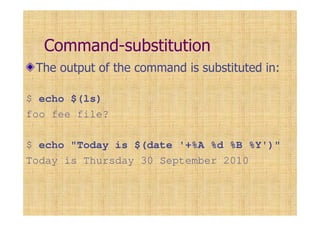
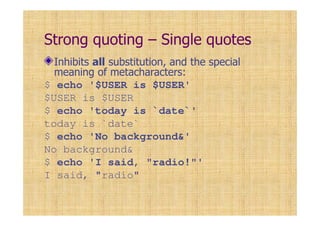

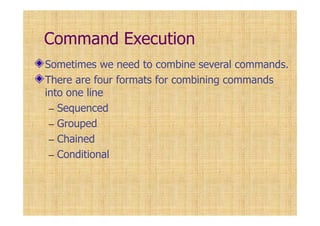
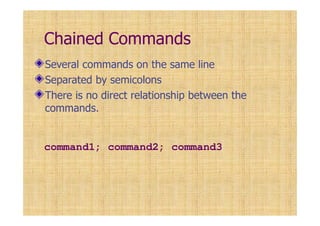
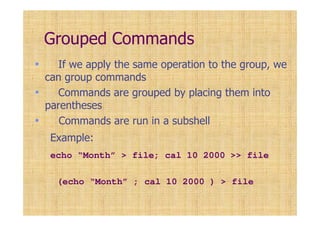
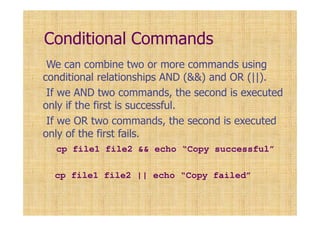
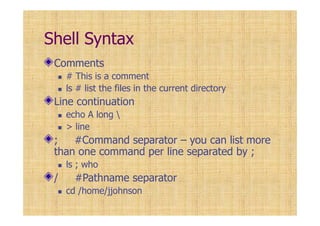
![Shell Syntax –
wildcards (globbing)
Wildcards, and pathname expansion
* # match any string (including empty)
? # match any single character
[set] # match characters listed in set (can be
range)
[!set] # match any character not given in set
Examples
ls *.c
ls *.?
ls *.[Hh][Tt][Ll]
ls [a-z]](https://image.slidesharecdn.com/shellscripting-160109063824/85/Shell-scripting-43-320.jpg)
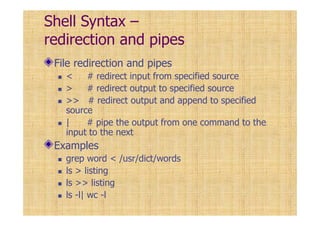
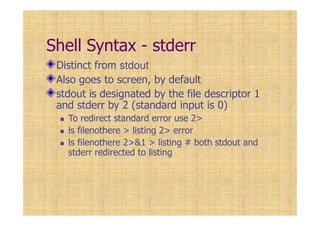
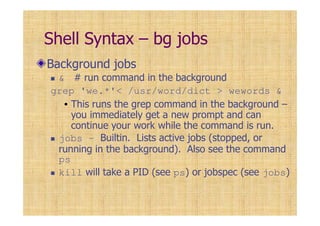
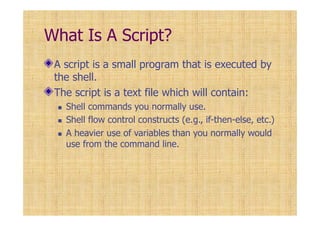
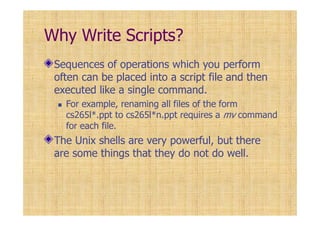
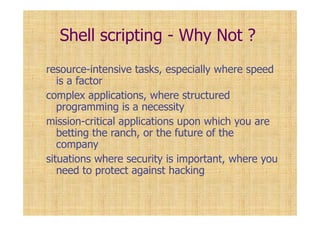
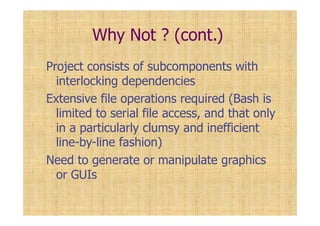
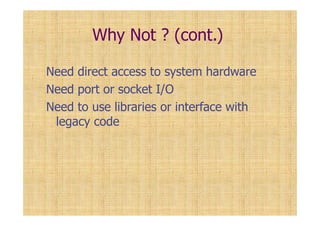

![Example: Simple Script
Let’s create a shell script to give us
information about the system.
We create the script using a text editor.
Let’s call the file “status”
#!/bin/bash
uptime
users # maybe hit [Enter] here
Exit the editor](https://image.slidesharecdn.com/shellscripting-160109063824/85/Shell-scripting-53-320.jpg)
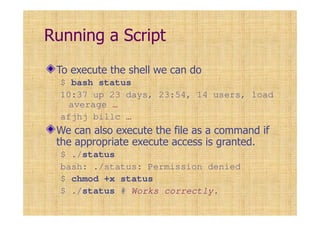
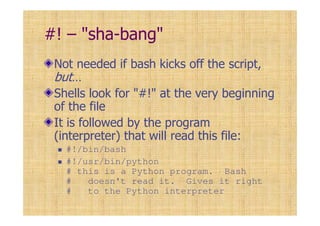

![test - Conditional Expressions
Actually a disk utility
[ is just shorthand
Provides for a great many tests
Is available to all shells
test expression
Or
[ expression ] Separate expression from brackets
spaces](https://image.slidesharecdn.com/shellscripting-160109063824/85/Shell-scripting-57-320.jpg)
![Cond. Expressions (cont)
test returns an exit status of zero (success) for
true
test uses a variety of operators
Unary file operators can test various file properties.
Here are just a few:
-e True if file exists
-f True if file is a regular file
-d True if file is a directory
-w True if file exists and is writable
-O True if I own the file
E.g.
if [ -e ~kschmidt/public_html ] ; then
echo "Kurt has a public web directory"
fi](https://image.slidesharecdn.com/shellscripting-160109063824/85/Shell-scripting-58-320.jpg)
![[] – file and string operators
Binary file operators “file1 op file2”
-nt True is file1 is newer than file2
-ot True is file1 is older than file2
-ef True if f1 and f2 refer to the same inode
Unary string operators “op string”
-z True if string is of zero length
-n True if string is not of zero length
-l Returns length of string
E.g.
if [ -z "$myVar" ] ; then
echo "$myVar has null length"
fi](https://image.slidesharecdn.com/shellscripting-160109063824/85/Shell-scripting-59-320.jpg)
![[] – string operators
These compare lexical order
== != < > <= >=
Note, < > are file redirection. Escape them
E.g.
if [ "abc" != "ABC" ] ; then
echo 'See. Case matters.' ; fi
if [ 12 < 2 ] ; then
echo "12 is less than 2?" ; fi](https://image.slidesharecdn.com/shellscripting-160109063824/85/Shell-scripting-60-320.jpg)
![[] – arithmetic operators
Only for integers
Binary operators:
-lt -gt -le -ge -eq -ne
E.g.
if [ 2 –le 3 ] ; then ;echo "cool!" ; fi
x=5
if [ "$x" –ne 12 ] ; then
echo "Still cool" ; fi](https://image.slidesharecdn.com/shellscripting-160109063824/85/Shell-scripting-61-320.jpg)
![[] – Logical Operators
Logical expression tools
! expression Logical not (I.e., changes sense of
expression)
e1 -a e2 True if both expressions are true.
e1 -o e2True if e1 or e2 is true.
( expression ) Works like normal parentheses for
expressions; use spaces around the
expression.
Examples:
test -e bin -a -d /bin is true
[ -e ~/.bashrc -a ! -d ~/.bashrc ] && echo true](https://image.slidesharecdn.com/shellscripting-160109063824/85/Shell-scripting-62-320.jpg)
![[[ test ]]
Bash added [[]] for more C-like usage:
if [[ -e ~/.bashrc && ! –d ~/.bashrc ]]
then
echo "Let's parse that puppy"
fi
if [[ -z "$myFile" || ! –r $myFile ]]
…
It's a built-in
Why sometimes quote $myFile, sometimes not (it's
usually a good idea to do so)?](https://image.slidesharecdn.com/shellscripting-160109063824/85/Shell-scripting-63-320.jpg)
![Arithmetic Expressions
Bash usually treats variables as strings.
You can change that by using the arithmetic
expansion syntax: (( arithmeticExpr ))
(()) shorthand for the let builtin statement
$ x=1
$ x=x+1 # "x+1" is just a string
echo $x
x+1
Note, $[] is deprecated](https://image.slidesharecdn.com/shellscripting-160109063824/85/Shell-scripting-64-320.jpg)
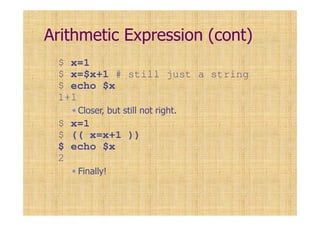
![Sample: Basic conditional
example if .. then
#!/bin/bash
if [ "$1" = "foo" ] ; then
echo expression
evaluated as true
fi](https://image.slidesharecdn.com/shellscripting-160109063824/85/Shell-scripting-66-320.jpg)
![Sample: Basic conditional
example if .. then ... else
#!/bin/bash
if [ "$1" = "foo" ]
then
echo 'First argument is "foo"'
else
echo 'First arg is not "foo"'
fi](https://image.slidesharecdn.com/shellscripting-160109063824/85/Shell-scripting-67-320.jpg)
![Sample: Conditionals with
variables
#!/bin/bash
T1="foo"
T2="bar"
if [ "$T1" == "$T2" ] ; then
echo expression evaluated as true
else
echo expression evaluated as false
fi
•Always quote variables in scripts!](https://image.slidesharecdn.com/shellscripting-160109063824/85/Shell-scripting-68-320.jpg)
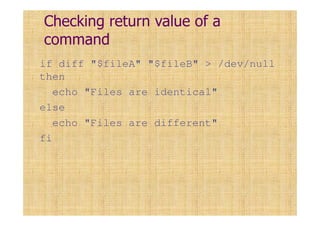
![Case Statement
case $opt in
a ) echo "option a";;
b ) echo "option b";;
c ) echo "option c";;
? ) echo
'usage: alice [-a] [-b] [-c] args...'
exit 1;;
esac](https://image.slidesharecdn.com/shellscripting-160109063824/85/Shell-scripting-70-320.jpg)
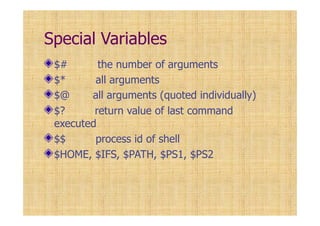
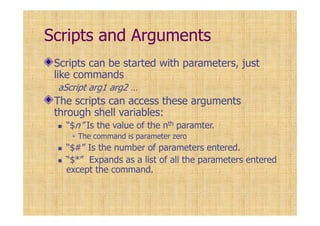
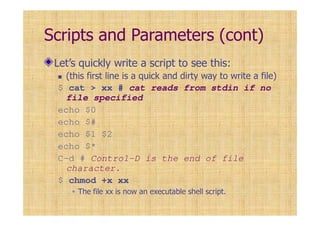
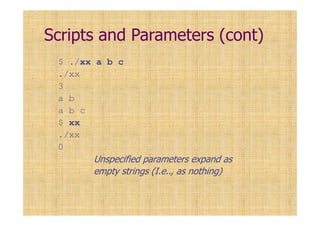
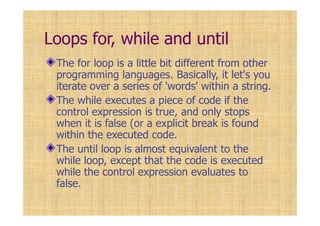


![While sample
COUNTER=0
while (( COUNTER < 10 )) ; do
echo The counter is $COUNTER
(( COUNTER = COUNTER+1 ))
done
COUNTER=0
while [ $COUNTER -lt 10 ] ; do
echo The counter is $COUNTER
let COUNTER=COUNTER+1
done](https://image.slidesharecdn.com/shellscripting-160109063824/85/Shell-scripting-78-320.jpg)
![Until sample
#!/bin/bash
COUNTER=20
until [ $COUNTER -lt 10 ]
do
echo COUNTER $COUNTER
let COUNTER-=1
done](https://image.slidesharecdn.com/shellscripting-160109063824/85/Shell-scripting-79-320.jpg)

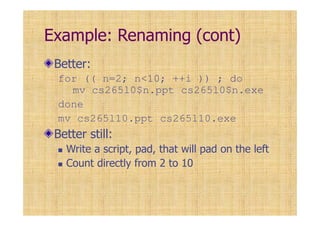
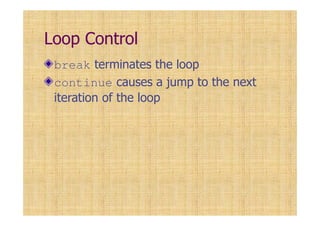
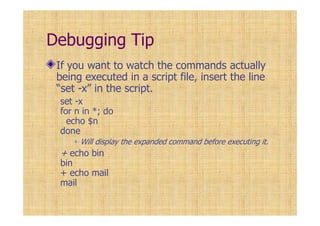
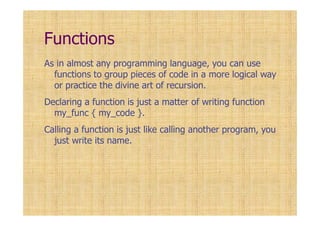
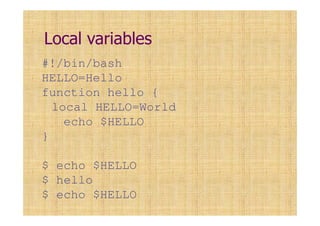
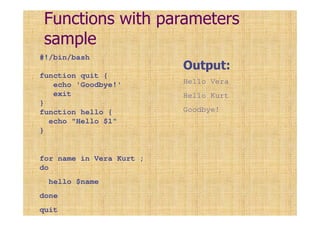
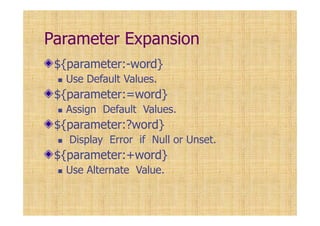
![More Parameter Expansion
We can remove parts of a value:
${param#pattern}
${param##pattern}
- removes shortest (#) or longest (##)
leading pattern, if there's a match
${param#pattern}
${param##pattern}
- removes shortest(%) or longest (%)
trailing pattern, if match
pattern is expanded just as in pathname
expansion (globbing) - *, ?, []](https://image.slidesharecdn.com/shellscripting-160109063824/85/Shell-scripting-88-320.jpg)
